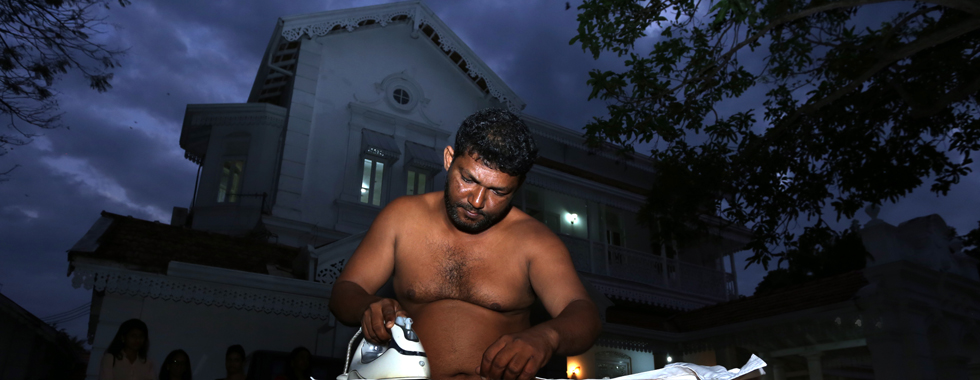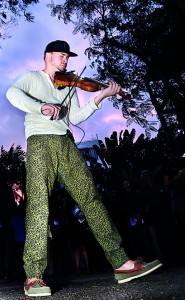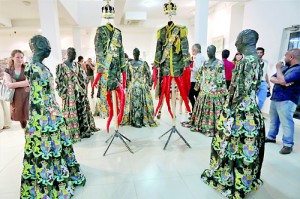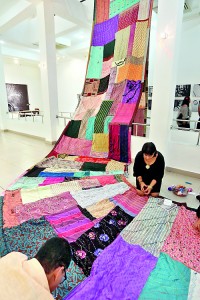The man who irons, a crown of little men; all making history
It is 8 p.m, and we’re just about to leave the building when a lady in saree asks us to follow her. Please note that in normal

A private act in a public place: Bandu Manamperi. Pix by M.A. Pushpa Kumara
circumstances it is never a good idea to follow strangers into the night, but this was the opening exhibition of the Colombo Art Biennale and we had already spent an evening far removed from the annals of normalcy. So follow her we do, out into a separate wing of the J.D.A. Perera Gallery, where a man with an eye patch and sunglasses of the blackest night asks each mystified visitor to hold a magnifying glass to a selection of vintage photos. You’re then asked to fill out a form with your observations.
We still have absolutely no idea what this is all about, but that’s alright because the Colombo Art Biennale will span over 10 days (January 31 to February 9), and will at some point reveal the motives behind this strange exercise (at least, we hope so!). The opening itself was a smorgasbord of all sorts of art; from towering installations to vivid paintings, audio and video creations to live art, guests were treated to a cross section of the biennale’s attractions, and that was just at the J.D.A. Perera Gallery. There are six other venues which will hold the main works of art, plus a few others which will be host to a selection of biennale events.
The evening began with a news conference at the Lakshman Kadirgamar Institute, where CAB founder and director Annoushka Hempel

A little night music: Violinist entertainer Eugene Draw
together with curators Neil Butler and Ruhanie Perera (with curator Amit Kumar Jain and co-founder Jagath Weerasinghe in the background) offered an insight into the premise of the biennale, back this year for the third time running. Themed under ‘Making History’ the 2014 CAB draws on the inspiration of 60 artists from Sri Lanka and around the world, making it possibly the largest yet. Hempel noted that the main premise of the biennale still remained the promotion of local artists but added that it was not just a platform for publicity but also for expression.
And what a mind-boggling show of expression it was. At the Kadirgamar Institute itself you’ll find the works of artist Kingsley Gunatillake, working with paper and bullets, while Lakisha Fernando recreates old buildings with paint on her postcards. Tristan al-Haddad’s Womb Tomb is a mass of bricks

Look closely: Jewellery designer Manori Jayasinghe’s crown
manipulated into a twisty vortex, and it’s best enjoyed when paired with live music by a violinist like we did. Clad in briefs, the mild-mannered Bandu Manamperi quietly irons a shirt and pants, eventually putting them on and walking away. What we saw was a man performing an intensely private and domestic act in public, shedding inhibitions and crossing the boundaries of the acceptable. The biennale guide tells us that this represents the act of ironing out the creases of the past and the creation of new history and identity. Whichever way you look at it, there’s something very personal about watching a stranger do his ironing.
At the J.D.A. Perera Gallery Kumari Kumaragamage challenges the linear form of narrative with excerpts from her work, while Eva Priyanka Wegener twirls and pirouettes her way through four floors of art, hotly pursued by a violinist. On entrance you’re confronted with Pala Pothupitiye’s towering metal sculpture, ‘History-maker’. Pothupitiye is known for his

Replacement: A work by Bangladeshi artist Mahbubur Rahman
cartographic art, and if you look closely you’ll see that the inner recesses of the sculpture are of a map. On the other end is a collage of development photographs, with an impressively moustachioed man in a loose shirt super-imposed onto the pictures. We’re looking at Pradeep Thalwatte’s ‘Roadscape’, informs the little tag. We find of more thought jewellery designer Manori Jayasinghe’s intricate crown, made of little army figurines held in place with pins.
Upstairs, Nina Mangalanayagam’s ‘The Folds of the Fabric Differently Each Time’ explores the in-betweens of culture. There’s one stiff family portrait which makes us smile-it is incredibly reminiscent of our grandparents and their own equally stiff

The Fireflies’ sarees: Memories in the stitches
black and white family photographs. We also find an interactive art piece which we particularly enjoy; called Zweintopf, it’s made up of old copy book pages with words of wisdom in curlicue. Black biros on the floor invite you to scrawl something underneath. ‘Idleness rusts the mind,’ says one and underneath it in shaky hand are four golden words-‘so does Justin Bieber’.
On the third level, you’ll find a collective of artists known as the Fireflies who’ve created another interactive work of art with a patchwork of sarees they spent three months collecting and piecing together.
We manage to steal a few words from Lakisha Fernando of the collective, who tells us that these sarees belong to their friends, family, colleagues, celebrities…you’ll even find a couple donated by veteran singer Nanda Malini here. They’re not just any old sarees either-each represents a special moment in the lives of the women who donated them “This is my homecoming saree,” we hear one lady say. The piece is a constantly evolving work of art as anyone can walk in and add their own stitch (or stiches) to the piece. “We all make history,” explains Therica Miyandeniya. I’m invited to make a stitch. I pick Nanda Malini’s saree, of course.
| The third edition of the Colombo Art Biennale continues until February 9. The main artists are exhibited in seven galleries around Colombo, including the Park Street Mews, Goethe Institut, Museum of Economic Development, the Lionel Wendt and Harold Pieris Galleries and the Post Graduate Institute of Archaeology in addition to the two mentioned above. Entrance is free.For the full programme of events, see www.colomboartbiennale.com |


